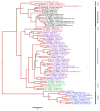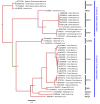Insect-specific flaviviruses: a systematic review of their discovery, host range, mode of transmission, superinfection exclusion potential and genomic organization
- PMID: 25866904
- PMCID: PMC4411683
- DOI: 10.3390/v7041927
Insect-specific flaviviruses: a systematic review of their discovery, host range, mode of transmission, superinfection exclusion potential and genomic organization
Abstract
There has been a dramatic increase in the number of insect-specific flaviviruses (ISFs) discovered in the last decade. Historically, these viruses have generated limited interest due to their inability to infect vertebrate cells. This viewpoint has changed in recent years because some ISFs have been shown to enhance or suppress the replication of medically important flaviviruses in co-infected mosquito cells. Additionally, comparative studies between ISFs and medically important flaviviruses can provide a unique perspective as to why some flaviviruses possess the ability to infect and cause devastating disease in humans while others do not. ISFs have been isolated exclusively from mosquitoes in nature but the detection of ISF-like sequences in sandflies and chironomids indicates that they may also infect other dipterans. ISFs can be divided into two distinct phylogenetic groups. The first group currently consists of approximately 12 viruses and includes cell fusing agent virus, Kamiti River virus and Culex flavivirus. These viruses are phylogenetically distinct from all other known flaviviruses. The second group, which is apparently not monophyletic, currently consists of nine viruses and includes Chaoyang virus, Nounané virus and Lammi virus. These viruses phylogenetically affiliate with mosquito/vertebrate flaviviruses despite their apparent insect-restricted phenotype. This article provides a review of the discovery, host range, mode of transmission, superinfection exclusion ability and genomic organization of ISFs. This article also attempts to clarify the ISF nomenclature because some of these viruses have been assigned more than one name due to their simultaneous discoveries by independent research groups.
Figures





Similar articles
-
The Black Book of Psychotropic Dosing and Monitoring.Psychopharmacol Bull. 2024 Jul 8;54(3):8-59. Psychopharmacol Bull. 2024. PMID: 38993656 Free PMC article. Review.
-
Sexual Harassment and Prevention Training.2024 Mar 29. In: StatPearls [Internet]. Treasure Island (FL): StatPearls Publishing; 2025 Jan–. 2024 Mar 29. In: StatPearls [Internet]. Treasure Island (FL): StatPearls Publishing; 2025 Jan–. PMID: 36508513 Free Books & Documents.
-
Short-Term Memory Impairment.2024 Jun 8. In: StatPearls [Internet]. Treasure Island (FL): StatPearls Publishing; 2025 Jan–. 2024 Jun 8. In: StatPearls [Internet]. Treasure Island (FL): StatPearls Publishing; 2025 Jan–. PMID: 31424720 Free Books & Documents.
-
A rapid and systematic review of the clinical effectiveness and cost-effectiveness of paclitaxel, docetaxel, gemcitabine and vinorelbine in non-small-cell lung cancer.Health Technol Assess. 2001;5(32):1-195. doi: 10.3310/hta5320. Health Technol Assess. 2001. PMID: 12065068
-
A Review of Flaviviruses that Have No Known Arthropod Vector.Viruses. 2017 Jun 21;9(6):154. doi: 10.3390/v9060154. Viruses. 2017. PMID: 28635667 Free PMC article. Review.
Cited by
-
Diversity and circulation of Jingmen tick virus in ticks and mammals.Virus Evol. 2020 Jul 27;6(2):veaa051. doi: 10.1093/ve/veaa051. eCollection 2020 Jul. Virus Evol. 2020. PMID: 33976906 Free PMC article.
-
The Chimeric Chaoyang-Zika Vaccine Candidate Is Safe and Protective in Mice.Vaccines (Basel). 2024 Feb 19;12(2):215. doi: 10.3390/vaccines12020215. Vaccines (Basel). 2024. PMID: 38400198 Free PMC article.
-
Discovery of Novel Viruses in Mosquitoes from the Zambezi Valley of Mozambique.PLoS One. 2016 Sep 28;11(9):e0162751. doi: 10.1371/journal.pone.0162751. eCollection 2016. PLoS One. 2016. PMID: 27682810 Free PMC article.
-
Antiviral RNAi Response against the Insect-Specific Agua Salud Alphavirus.mSphere. 2022 Feb 23;7(1):e0100321. doi: 10.1128/msphere.01003-21. Epub 2022 Feb 16. mSphere. 2022. PMID: 35171691 Free PMC article.
-
A Novel Flavi-like Virus in Alfalfa (Medicago sativa L.) Crops along the Snake River Valley.Viruses. 2022 Jun 16;14(6):1320. doi: 10.3390/v14061320. Viruses. 2022. PMID: 35746792 Free PMC article.
References
-
- Lindenbach B.D., Thiel H.-J., Rice C.M. Flaviviridae: The viruses and their replication. In: Knipe D.M., Howley P.M., editors. Fields Virology. 5th ed. Lippincott Williams and Wilkins; Philadelphia, PA, USA: 2007. pp. 1101–1152.
-
- Gubler D.J., Kuno G., Markoff L. Flaviviruses. In: Knipe D.M., Howley P.M., editors. Fields Virology. 5th ed. Lippincott Williams and Wilkins; Philadelphia, PA, USA: 2007. pp. 1153–1252.
-
- Johnson H.N. Ecological implications of antigenically related mammalian viruses for which arthropod vectors are unknown and avian associated soft tick viruses. Jpn. J. Med. Sci. Biol. 1967;20(Suppl):160–166. - PubMed
Publication types
MeSH terms
Grants and funding
LinkOut - more resources
Full Text Sources
Other Literature Sources
Molecular Biology Databases

